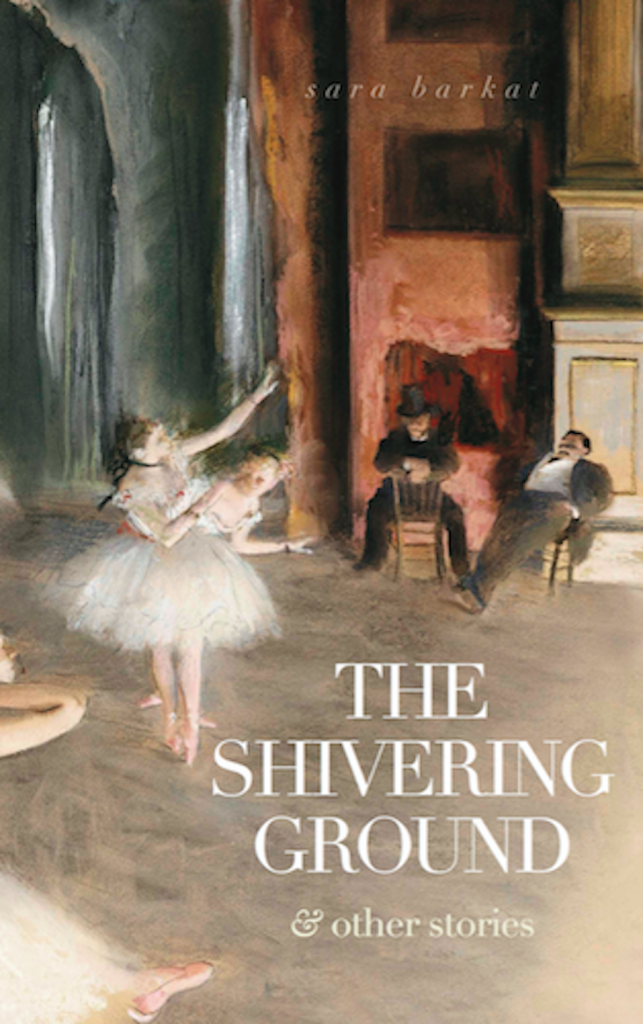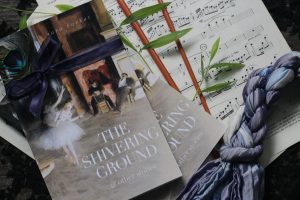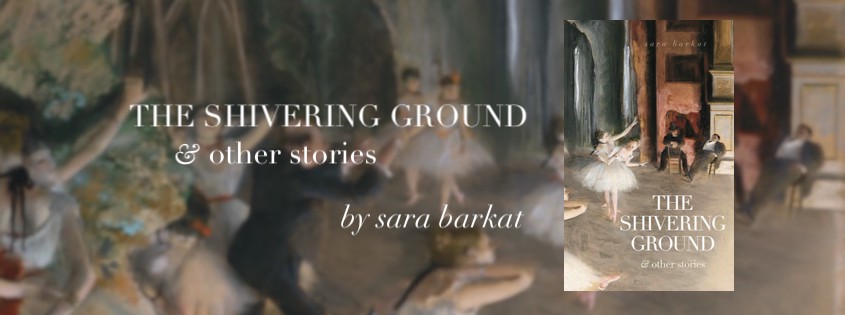
The Shivering Ground & other stories
by Sara Barkat
Genre: Science fiction/fantasy/horror/ecofiction
Publisher: T.S. Poetry Press
Cover Artist: Edward Degas
Release Date: December 1, 2021
Page Count: 150 CONTENT
Warnings: Death, suicide, war, mass extinction, self harm
The Shivering Ground blends future and past, earth and otherworldliness, in a magnetic collection that shimmers with art, philosophy, dance, film, and music at its heart. A haunting medieval song in the mouth of a guard, an 1800s greatcoat on the shoulders of a playwright experiencing a quantum love affair, alien worlds both elsewhere and in the ruined water at our feet: these stories startle us with the richness and emptiness of what we absolutely know and simultaneously cannot pin into place. In the tender emotions, hidden ecological or relational choices, and the sheer weight of a compelling voice, readers “hear” each story, endlessly together and apart.
The word ‘original,’ as a compliment, is both overused and quite often misused. But sometimes it’s the only word that will do. Sara Barkat is an original. Her imagination is imperious; she wields words as she pleases, in ways that delight and unsettle. In this, she reminds me of Emily Dickinson. Reading her, I expect you will agree. Don’t miss the opportunity. —John Wilson, editor of Books & Culture (1995-2016)
Excerpt:
The mannequin with my heart in it stands in the corner, dusty. It has been that way for years. In the early days I would try futilely to dust round it, and when the feathers on the duster, my thin appendage, dragged across that cold aluminum collarbone and the plume of dust leapt up in answer, it would hover, bombinating, susurrating, droning…nothing but flecks of dust, thin-sharded and shining, mica and talc. I got tired of that dust, and the way the windowpane beyond it reeked of grime, and the way I never had to stand on tiptoe or crouch—the mannequin with its knobbed spine and the crooked jaunty tilt of its ear, circles upon circles of insets swirled within brass was always exactly my height. It did not have my hair. It did not, really, have even my shape, but its eyes were like mine, only flat and as completely lifeless as anything can give impression of being.
Author Interview:
1. What inspired you to write this book?
I was inspired by a dream I had, actually, of an unusual/creepy garden behind a door in a wall. It was like a surreal painting—and the feeling of it stuck with me, and made me think of how many stories I love that start with the entrance into another world (The Secret Garden, Narnia, etc) and how the idea of an entrance itself is so powerful. That’s the idea that led me to “The Door at the End of the Path” which deals with a child’s own personal entrance into the unknown. After that, I just thought, well if I’ve written one short story, I should write other stories to go with it.
2. What, if anything, did you learn when writing the book?
I learned about a number of extinct birds for “Noticing.” For the same story I also learned that there was an ancient Egyptian constellation called The Geese of Ra, and no one now knows what stars it refers to. And that Roly-poly bugs are related to shrimp! They breathe through gills, and that’s why they hang out under logs—where it’s moist. While writing “A Universe Akilter,” I also discovered a rival pair of painters in Ancient Greece, with an amusing story attached: one supposedly fooled the birds with his realistic painting of grapes and the other fooled his rival with realistic drapes.
3. What surprised you the most in writing it?
Just the fact that I was able to finish it at all, really.
4. What does the title mean?
The title of the book is a reference to the second-to-last story in the volume, “The Shivering Ground,” which is a story all about sound, music, and uncertainty.
5. Do you consider the book to have a lesson or moral?
I don’t think books should have lessons or morals—I think they should be entertaining and thought-provoking. However, I did want to draw attention with this book to the *feeling* ecological disintegration engenders in people—taking it away from politics or even right and wrong to deal with the terror and grief of seeing something you love destroyed.
6. What is your favorite part of the book?
That’s hard to say. I like all the stories… but it might be Noticing. It was a real challenge to pull off, and I’m satisfied with the result.
7. Which character was most challenging to create? Why?
I found Pari and Min, the characters in “The Day Before Tomorrow” somewhat challenging, because unlike the other characters in the volume, they couldn’t be defined by their actions. So, instead, I had to try to make them compelling through their ordinary lives, through what they did on a very small scale, what they thought, and how they interacted with each other.
8. What are your immediate future plans?
I have an eco-poem anthology coming out in April next year, collecting all sorts of wonderful poems from a wide range of writers, including many works in translation. It’s called Earth Song because the placement of the poems is supposed to feel like movements of an orchestral piece, where each flows into the next instead of being placed statically. It’s meant to draw attention to the connections between the pieces, and showcases moments of encounter between humanity and nature, focusing on a variety of emotions. The collection is framed through poems by Sara Teasdale and Gerard Manley Hopkins, and includes both famous and emerging poets. Pablo Neruda, Jane Hirshfield, Major Jackson, W. S. Merwin, Gerald Vizenor, Louise Erdrich, Rabindranath Tagore, and many more.

About the Author:
Sara Barkat is an intaglio artist and writer with an educational background in philosophy and psychology, whose work has appeared in Every Day Poems, Tweetspeak Poetry, and Poetic Earth Month—as well as in the book How to Write a Poem: Based on the Billy Collins Poem “Introduction to Poetry.” Sara has served as an editor on a number of titles including the popular The Teacher Diaries: Romeo & Juliet, and is the illustrator of The Yellow Wall-Paper Graphic Novel, an adaptation of the classic story by Charlotte Perkins Gilman.


